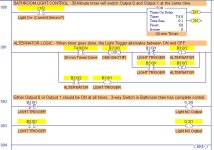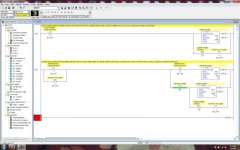I've been tasked with designing a new Homes automation with a PLC.
First issue is an option the client wanted.
Lets say we have a bathroom and the light inside was hooked up to the PLC for control. Lets say that after 30 minutes no one has turned it off, the PLC will turn it off.
I am perplexed as to how I would do this with Minimal wires. Lets say this is an existing home (already built) and it never had automation, my first idea was to place Solid State Relays near the Electrical Panel and have every electrical wires from the panel go through the SSR before going out to the wall switch and light.
This is fine I can install a current sensor and start a countdown in the PLC for 30 minutes and turn off the SSR (Done) light is off. But the PROBLEM now is how does the USER get the light to come back on???. Person goes into the bathroom and flickers the switch but nothing happens?
I'm sure their are all kinds of solutions, I've thought of a few but required WAY!!! to many cable runs for extra inputs or sensors.
Is their some way to do this in a simplistic way??
Thanks in advance for any help.
Ray
First issue is an option the client wanted.
Lets say we have a bathroom and the light inside was hooked up to the PLC for control. Lets say that after 30 minutes no one has turned it off, the PLC will turn it off.
I am perplexed as to how I would do this with Minimal wires. Lets say this is an existing home (already built) and it never had automation, my first idea was to place Solid State Relays near the Electrical Panel and have every electrical wires from the panel go through the SSR before going out to the wall switch and light.
This is fine I can install a current sensor and start a countdown in the PLC for 30 minutes and turn off the SSR (Done) light is off. But the PROBLEM now is how does the USER get the light to come back on???. Person goes into the bathroom and flickers the switch but nothing happens?
I'm sure their are all kinds of solutions, I've thought of a few but required WAY!!! to many cable runs for extra inputs or sensors.
Is their some way to do this in a simplistic way??
Thanks in advance for any help.
Ray









